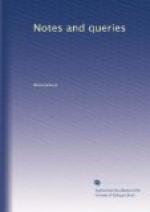W. DN.
Saying of Montaigne (Vol. ii., p. 278.).—I have seen this attributed to Fenelon, and, I think, to an English divine; but have no “Note,” and regret I cannot recollect the name.
ESTE.
Scala Coeli (Vol. ii., p. 285.)—They are not in the church of St. John Lateran, but in a separate portico-like building. They form the middle flight, up which the faithful ascend on their knees, and descend by ordinary stairs on each side. These stairs are of stone (or marble), and are covered with boards, so that only parts are visible. They are said to have formed part of Pilate’s house at Jerusalem; but I believe there are other claimants for the honour. One or two brass stars, inlaid in the stone, are said to mark the spots where Christ’s tears fell.
ESTE.
Birmingham, Nov. 13. 1850.
Red Hand—Holt Family—Aston Church (Vol. ii., p. 241.).—The tradition is not, I belive, of very ancient date. It is stated that one of the Holt family murdered his cook, and was afterwards compelled to adopt the red hand in his arms. It is, however, obviously only the “Ulster badge” of baronetcy. I have never heard any further particulars of the tradition.
ESTE.
Swearing by Swans (Vol. ii., p. 392.).—
“Toison d’or parut ensuite; il apportait un faisan vivant, orne d’un collier d’or; alors le duc Philippe, suivant l’ancien usage qu’avaient les seigneurs de preter leurs serments sur quelque noble oiseau, jura qu’il irait en personne dans l’Orient combattre le chef des Sarrasins.” &c., &c.—Histoire des Ducs de Bourgogne, par F. Valentin, troisieme edition, p. 235. 8vo. Tours, 1846.
E.J.M.
Oxford.
{452} "Tickhill, God help me!" (Vol. i., p. 247.).—Chagford, on the borders Dartmoor, in Devon, is in winter a very desolate and almost unapproachable place. If an inhabitant be asked at this season concerning his locality, he calls it, in sad tones, “Chagford, good Lord!” In summer the place is picturesque and much sought, and then the exulting designation is “Chaggiford, and what d’ye think?”
Widdicombe-in-the-Moor, in the same neighbourhood, is a most out-of-the-way place, and is commonly spoken of as “Widdicombe in the cold country, good Lord!”
J.W.H.
"Noli me tangere" (Vol. ii., p. 253.).—To the list given of the painters of this subject may be added Frederico Baroccio. A singularly beautiful engraving by Raphael Morghen of this picture, then in the possession of the Marquis Bonvisi of Lucca, was published at Florence, 1816.
C.I.R.
Judas Bell, Judas Candle, &c. (Vol. ii., p. 298.).—In the parish accounts of Lambeth, the two following entries occur:—
“1516. To James Calcot for
payntyng of Judas, 6d.”
“1523. Paid for a staff for
Judas crosse — 4d.”
I venture to add these to the instances cited by Mr. Walcott, hoping that the slightly varied form may furnish a clue by which some of your readers may be able to unravel the meaning of such allusions more satisfactorily than any yet attempted.




